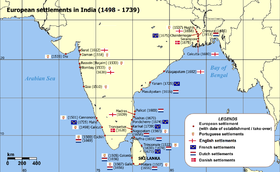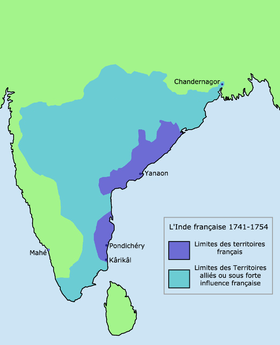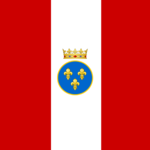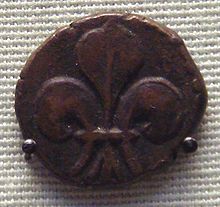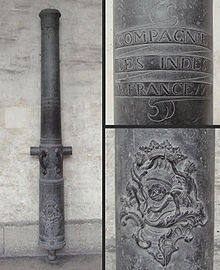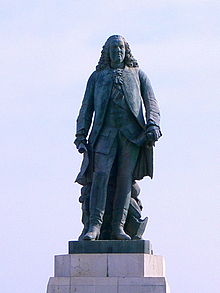- French East India Company
-
French East India Company 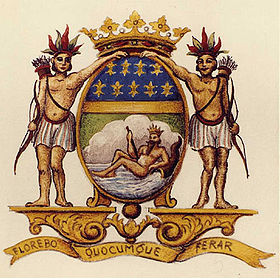
Type Public company Industry Trade Fate Dissolved and activities absorbed by the French Crown in 1769; reconstituted 1785, bankrupt 1794 Founded 1664 Headquarters Paris The French East India Company (French: La Compagnie française des Indes orientales or Compagnie française pour le commerce des Indes orientales) was a commercial enterprise, founded in 1664 to compete with the British and Dutch East India companies in colonial India.
Planned by Jean-Baptiste Colbert, it was chartered by King Louis XIV for the purpose of trading in the Eastern Hemisphere. It resulted from the fusion of three earlier companies, the 1660 Compagnie de Chine, the Compagnie d'Orient and Compagnie de Madagascar. The first Director General for the Company was De Faye, who was adjoined two Directors belonging to the two most successful trading organizations at that time: François Caron, who had spent 30 years working for the Dutch East India Company, including more than 20 years in Japan,[1] and Marcara Avanchintz, a powerful Armenian trader from Ispahan, Persia.[2]
Contents
History
The first state-sponsored French voyage to the Indies occurred in 1603, a voyage captained by Paulmier de Gonneville of Honfleur. French king Henry IV authorized the first Compagnie des Indes Orientales, granting the firm a 15-year monopoly of the Indies trade.[3] This precursor to Colbert's later Compagnie des Indes Orientales, however, was not a joint-stock corporation, and was funded by the Crown.
The initial capital of the revamped Compagnie des Indes Orientales was 15 million livres, divided into shares of 1000 livres apiece. Louis XIV funded the first 3 million livres of investment, against which losses in the first 10 years were to be charged.[3] The initial stock offering quickly sold out, as courtiers of Louis XIV recognized that it was in their interests to support the King’s overseas initiative. The Compagnie des Indes Orientales was granted a 50-year monopoly on French trade in the Indian and Pacific Oceans, a region stretching from the Cape of Good Hope to the Straits of Magellan.[3] The French monarch also granted the Company a concession in perpetuity for the island of Madagascar, as well as any other territories it could conquer.
The Company failed to found a successful colony on Madagascar, but was able to establish ports on the nearby islands of Bourbon and Île-de-France (today's Réunion and Mauritius). By 1719, it had established itself in India, but the firm was near bankruptcy. In the same year the Compagnie des Indes Orientales was combined under the direction of John Law with other French trading companies to form the Compagnie Perpétuelle des Indes). The reorganized corporation resumed its operating independence in 1723.
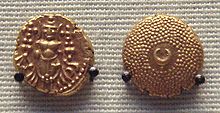 French-issued "Gold Pagoda" for Southern India trade, cast in Pondicherry 1705-1780.
French-issued "Gold Pagoda" for Southern India trade, cast in Pondicherry 1705-1780.
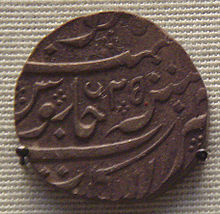 French-issued rupee in the name of Mohammed Shah (1719-1748) for Northern India trade, cast in Pondicherry.
French-issued rupee in the name of Mohammed Shah (1719-1748) for Northern India trade, cast in Pondicherry.
With the decline of the Mughal Empire, the French decided to intervene in Indian political affairs to protect their interests, notably by forging alliances with local rulers in south India. From 1741 the French under Joseph François Dupleix pursued an aggressive policy against both the Indians and the British until they ultimately were defeated by Robert Clive. Several Indian trading ports, including Pondicherry and Chandernagore, remained under French control until 1954.
The Company was not able to maintain itself financially, and it was abolished in 1769, about 20 years before the French Revolution. King Louis XVI issued a 1770 edict that required the Company to transfer to the state all its properties, assets and rights, which were valued at 30 million livres. The King agreed to pay all of the Company’s debts and obligations, though holders of Company stock and notes received only an estimated 15 percent of the face value of their investments by the end of corporate liquidation in 1790.[3]
The company was reconstituted in 1785[4] and issued 40,000 shares of stock priced at 1,000 livres apiece.[3] It was given monopoly on all trade with countries beyond the Cape of Good Hope[4] for an agreed period of seven years.[3] The agreement, however, did not anticipate the French Revolution, and on 3 April 1790 the monopoly was abolished by an act of the new French Assembly which enthusiastically declared that the lucrative Far Eastern trade would henceforth be "thrown open to all Frenchmen".[4] The company, accustomed neither to competition nor official disfavor, fell into steady decline and was finally liquidated in 1794.[3]
Liquidation scandal
Even as the company was headed consciously toward extinction, it became embroiled in its most infamous scandal. The Committee of Public Safety had banned all joint-stock companies on 24 August 1793, and specifically seized the assets and papers of the East India Company.[5] While its liquidation proceedings were being set up, directors of the company bribed various senior state officials to allow the company to carry out its own liquidation, rather than be supervised by the government.[5] When this became known the following year, the resulting scandal led to the execution of key Montagnard deputies like Fabre d'Eglantine and Joseph Delaunay, among others.[5] The infighting sparked by the episode also brought down Georges Danton[6] and can be said to have led to the downfall of the Montagnards as a whole.[5]
See also
- France-Asia relations
- Carnatic Wars
- British East India Company, founded in 1600
- Dutch East India Company, founded in 1602
- Dutch West India Company, founded in 1621
- Swedish East India Company, founded in 1731
- French colonial empire
- French India
- Lorient
- Chanda Sahib
- Muzaffar Jang
- Salabat Jang
Notes
Sources
- Ames, Glenn J. (1996). Colbert, Mercantilism, and the French Quest for Asian Trade. DeKalb, IL: Northern Illinois University Press. ISBN 0-87580-207-9.
- Boucher, P. (1985). The Shaping of the French Colonial Empire: A Bio-Bibliography of the Careers of Richelieu, Fouquet and Colbert. New York: Garland.
- Doyle, William (1990). The Oxford History of the French Revolution (2 ed.). Oxford; New York: Oxford University Press. ISBN 9780199252985.
- Lokke, C. L. (1932). France and the Colonial Question: A Study of Contemporary French Public Opinion, 1763-1801. New York: Columbia University Press.
- Malleson, G. B. (1893). History of the French in India. London: W.H. Allen & Co. http://www.archive.org/details/historyoffrenchi00mallrich.
- Sen, S. P. (1958). The French in India, 1763-1816. Calcutta: Firma K.L. Mukhopadhyay. ASIN B000HINRSC.
- Sen, S. P. (1947). The French in India: First Establishment and Struggle. Calcutta: University of Calcutta Press.
- Soboul, Albert (1975). The French Revolution 1787–1799. New York: Vintage. ISBN 039471220X. http://books.google.com/books?id=2gt4AAAAIAAJ&dq=isbn:039471220X&cd=1. Retrieved 2011-01-01.
- Subramanian, Lakshmi, ed. (1999). French East India Company and the Trade of the Indian Ocean: A Collection of Essays by Indrani Chatterjee. Delhi: Munshiram Publishers.
- McAbe, Ina Baghdiantz (2008). Orientalism in early Modern France. Berg. ISBN 9781845203740. http://books.google.com/books?id=LK0iAQAAIAAJ&dq=isbn:9781845203740&cd=1. Retrieved 2011-01-01.
External links
- Museum of the French East India Company at Lorient
- The French East India Company (1785-1875) History of the last French East India Company on the site dedicated to its business lawyer Jean-Jacques Regis of Cambaceres.
- French East Indies Company nowadays
French overseas empire Former Former French colonies in Africa and the Indian Ocean Maghreb - Algeria
- Morocco (Arguin Island)
- Tunisia
French West Africa French Equatorial Africa Comoros - French Somaliland (Djibouti)
- Madagascar
- Ile de France
- Seychelles
Former French colonies in the Americas Inini · Berbice · Saint-Domingue (Haiti) · Tobago · Virgin Islands · France Antarctique · Equinoctial FranceFormer French colonies in Asia and Oceania French India Indochinese Union French Mandate for Syria and the Lebanon Oceania France-Asia relations · French East India CompanyPresent  Overseas departments and territories of France
Overseas departments and territories of FranceInhabited areas 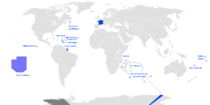 Special status
Special statusUninhabited areas Pacific Ocean French Southern and
Antarctic LandsBanc du Geyser4 · Bassas da India4 · Europa Island4 · Glorioso Islands3, 4, 5 · Juan de Nova Island4 · Tromelin Island4, 51 Also known as overseas regions. 2 Claimed by Comoros. 3 Claimed by Madagascar. 4 Claimed by Seychelles. 5 Claimed by Mauritius.Categories:
Wikimedia Foundation. 2010.

